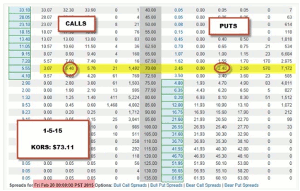For the benefit of options traders and given the fact that January 5 was the worst day the market experienced in over three months, Alan Ellman, of TheBlueCollarInvestor.com, shares a hypothetical trade representing an unscientific study, based on a real-time options chain.
Can we use covered call writing and selling cash-secured puts to generate profits when share price declines by 10% in two months in a bear or volatile market environment? I am writing this article on January 5th, 2015, the worst day the market has experienced in over three months. This hypothetical trade represents an unscientific study based on a real-life options chain and many of the BCI guidelines and rules. Here are the assumptions for this 2-month trade:
- We are in a bear or volatile market environment that will last for at least two months
- Share price will decline 10% in two months, we’ll assume 5% per month
- Market concern dictates the use of out-of-the-money puts (strike price below stock price) and in-the-money calls (call price below stock price)
- We will estimate monthly returns for the calls and puts by using a 6-week options chain and converting to monthly percentages
- We will assume no exit strategies will be required
- The stock selected is KORS as of 1-5-15
With the price of KORS at $73.11 near market close on 1-5-15 this is the real-life options chain for the 6-week February expiration:

KORS options chain on 1-5-15
Click to Enlarge
Initial trade
Since we are concerned about current market conditions, we will start by selling an out-of-the-money cash-secured put and converting the 6-week return into a one-month return. With KORS trading at $73.11, the $70 out-of-the-money put generates $2.40. Let’s take off our shoes and socks and do the math:
$2.40/($70 – $2.40) = 3.55%, six-week return = 2.6%, one-month return. Note that our breakeven is $70 – $2.40 = $67.60. If share price declines by 5% to $69.45, we are still in a profitable situation.
Status at first month expiration
Let’s assume share price drops by 5% and the shares are put to us at $70. Since we are still concerned about the overall market environment, we will write an in-the-money covered call. Using the same formula as we did for the put calculations, we see a six-week return for an in-the-money call of $5.40. Since the current call is more than $3 in-the-money, we will assume the call strike to be $66 (not scientific but hopefully meaningful enough to make a point). The six-week return for the above $70 in-the-money call is ($5.40 – $3.11)/($73.11 – $3.11) = 3.27% which converts to a one-month return of 2.36%. Note that our new breakeven is between $64 and $65 dollars with current share value at $$69.45. Once again, we will assume another 5% decline in share value from $69.45 to $65.97, near the $66 in-the-money call strike and well above breakeven.
What is our cost basis?
Let’s calculate without using time value profit to reduce our cost basis (don’t do this for tax purposes). Shares were put to us at $70 and the intrinsic value of the call premium brought down our cost basis to about $66. This is very close to the current projected price of $65.97. Our two-month profit is 2.6% + 2.36% = 4.96% which annualizes to 30%. Now, even if the numbers fall less favorably for us, we still have plenty of room for a palatable outcome in a bear market environment.
Summary
Option selling can result in monthly profits even in bear and volatile market conditions. This article, although unscientific in nature, represents some general points to support this conclusion.
By Alan Ellman of TheBlueCollarInvestor.com





















